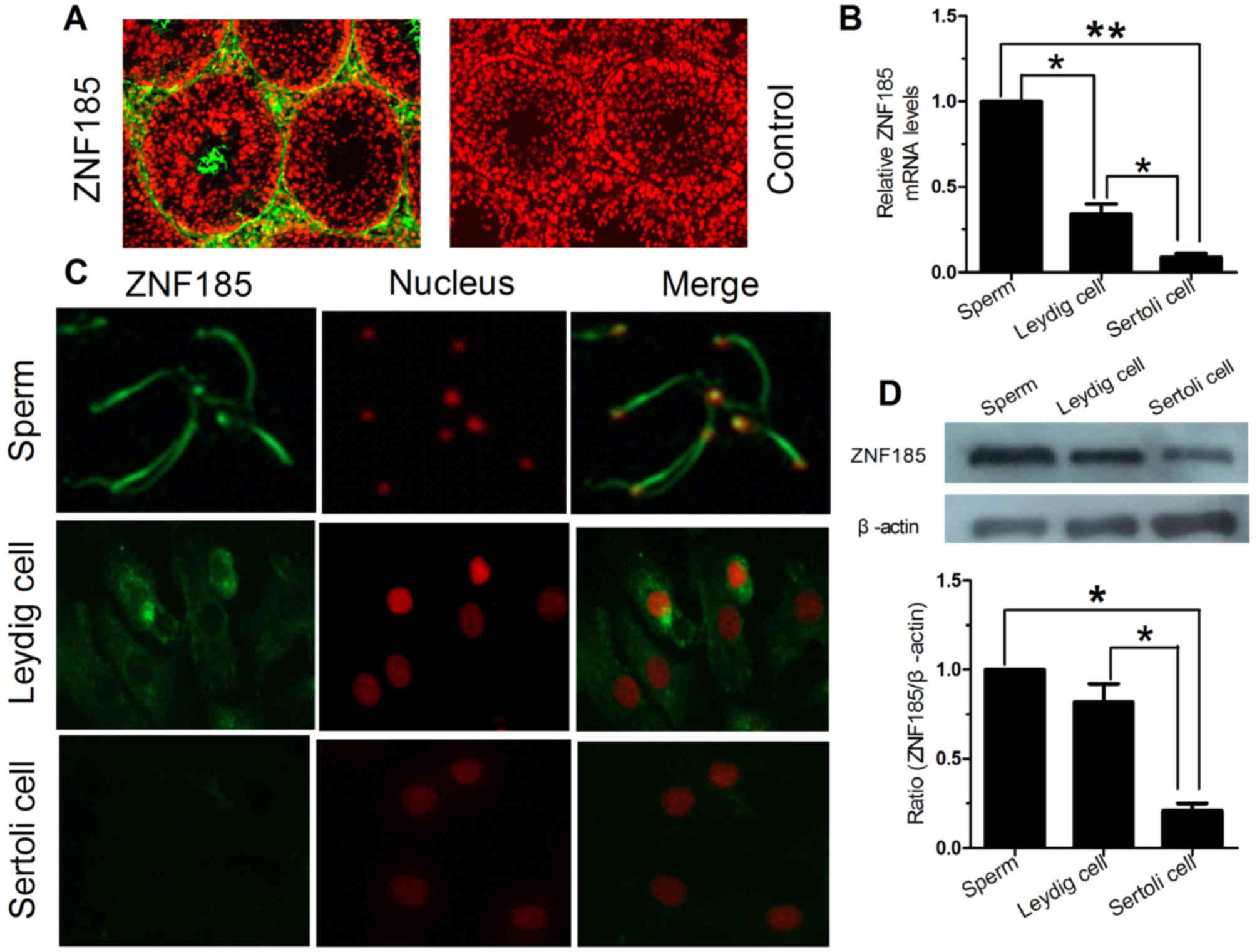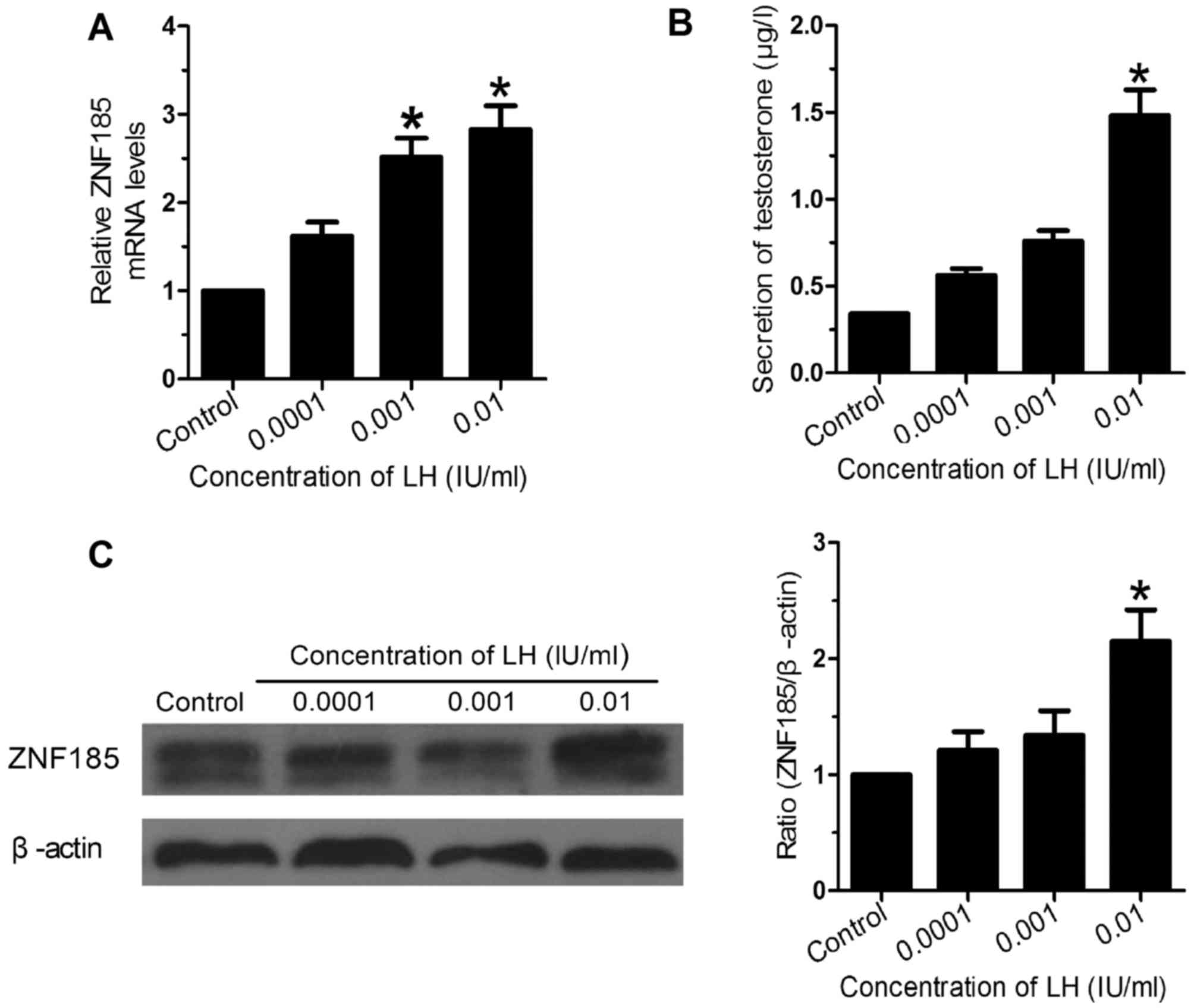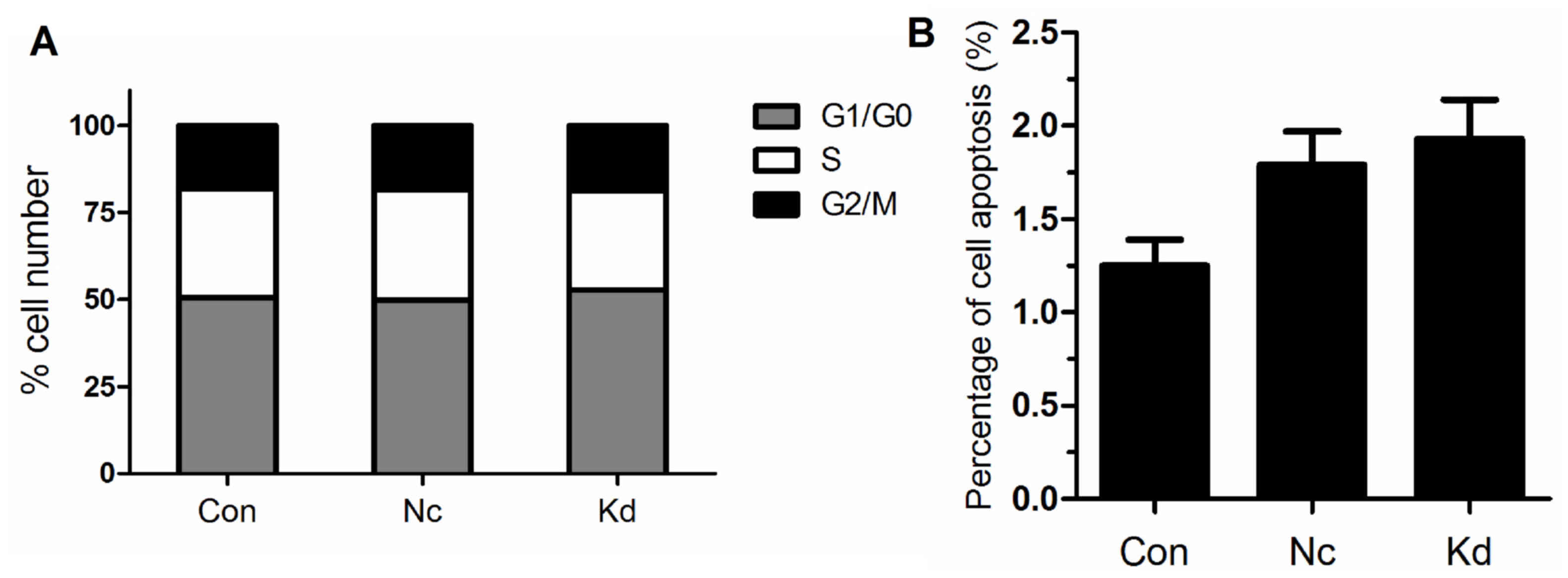|
1
|
Alexandrova ML and Bochev PG: Reduced
extracellular phagocyte oxidative activity, antioxidant level
changes and increased oxidative damage in healthy human blood as a
function of age. Age. 31:99–107. 2009. View Article : Google Scholar : PubMed/NCBI
|
|
2
|
Chen H, Cangello D, Benson S, Folmer J,
Zhu H, Trush MA and Zirkin BR: Age-related increase in
mitochondrial superoxide generation in the testosterone-producing
cells of Brown Norway rat testes: Relationship to reduced
steroidogenic function? Exp Gerontol. 36:1361–1373. 2001.
View Article : Google Scholar : PubMed/NCBI
|
|
3
|
Sharpe RM, Maddocks S, Millar M, Kerr JB,
Saunders PTK and Mckinnell C: Testosterone and spermatogenesis
identification of stage-specific, androgen-regulated proteins
secreted by adult rat seminiferous tubules. J Androl. 13:172–184.
1992.PubMed/NCBI
|
|
4
|
Zirkin BR and Tenover JL: Aging and
declining testosterone: Past, present, and hopes for the future. J
Androl. 33:1111–1118. 2012. View Article : Google Scholar : PubMed/NCBI
|
|
5
|
Walker WH: Molecular mechanisms of
testosterone action in spermatogenesis. Steroids. 74:602–607. 2009.
View Article : Google Scholar : PubMed/NCBI
|
|
6
|
Ahn SW, Gang GT, Kim YD, Ahn RS, Harris
RA, Lee CH and Choi HS: Insulin directly regulates steroidogenesis
via induction of the orphan nuclear receptor DAX-1 in testicular
Leydig cells. J Biol Chem. 288:15937–15946. 2013. View Article : Google Scholar : PubMed/NCBI
|
|
7
|
Matzkin ME, Yamashita S and Ascoli M: The
ERK1/2 pathway regulates testosterone synthesis by coordinately
regulating the expression of steroidogenic genes in Leydig cells.
Mol Cell Endocrinol. 370:130–137. 2013. View Article : Google Scholar : PubMed/NCBI
|
|
8
|
Mishra J, Gautam M, Dadhich R, Kowtharapu
BS and Majumdar SS: Peritubular cells may modulate Leydig
cell-mediated testosterone production through a nonclassic pathway.
Fertil Steril. 98:1308–1317.e1. 2012. View Article : Google Scholar : PubMed/NCBI
|
|
9
|
Ma J, Mi C, Wang KS, Lee JJ and Jin X:
Zinc finger protein 91 (ZFP91) activates HIF-1α via NF-κB/p65 to
promote proliferation and tumorigenesis of colon cancer.
Oncotarget. 7:36551–36562. 2016.PubMed/NCBI
|
|
10
|
Tseng KY and Lin S: Zinc finger factor 521
enhances adipogenic differentiation of mouse multipotent cells and
human bone marrow mesenchymal stem cells. Oncotarget.
6:14874–14884. 2015. View Article : Google Scholar : PubMed/NCBI
|
|
11
|
Yang F, Ma H, Feng L, Lian M, Wang R, Fan
E and Fang J: Zinc finger protein x-linked (ZFX) contributes to
patient prognosis, cell proliferation and apoptosis in human
laryngeal squamous cell carcinoma. Int J Clin Exp Pathol.
8:13886–13899. 2015.PubMed/NCBI
|
|
12
|
Buchner DA, Charrier A, Srinivasan E, Wang
L, Paulsen MT, Ljungman M, Bridges D and Saltiel AR: Zinc finger
protein 407 (ZFP407) regulates insulin-stimulated glucose uptake
and glucose transporter 4 (Glut4) mRNA. J Biol Chem. 290:6376–6386.
2015. View Article : Google Scholar : PubMed/NCBI
|
|
13
|
Zhang S, Qiu W, Wu H, Zhang G, Huang M,
Xiao C, Yang J, Kamp C, Huang X, Huellen K, et al: The shorter zinc
finger protein ZNF230 gene message is transcribed in fertile male
testes and may be related to human spermatogenesis. Biochem J.
359:721–727. 2001. View Article : Google Scholar : PubMed/NCBI
|
|
14
|
Zhou H, Liu LH, Zhang H, Lei Z and Lan ZJ:
Expression of zinc finger protein 105 in the testis and its role in
male fertility. Mol Reprod Dev. 77:511–520. 2010. View Article : Google Scholar : PubMed/NCBI
|
|
15
|
Cao Y, Li JX, Ji CN, Xu XW and Wu M:
Molecular cloning and characterization of a novel splice variant of
human ZNF300 gene, which expressed highly in testis. DNA Seq.
18:312–315. 2007. View Article : Google Scholar : PubMed/NCBI
|
|
16
|
Heiss NS, Gloeckner G, Bächner D, Kioschis
P, Klauck SM, Hinzmann B, Rosenthal A, Herman GE and Poustka A:
Genomic structure of a novel LIM domain gene (ZNF185) in Xq28 and
comparisons with the orthologous murine transcript. Genomics.
43:329–338. 1997. View Article : Google Scholar : PubMed/NCBI
|
|
17
|
Furukawa D, Chijiwa T, Matsuyama M, Mukai
M, Matsuo EI, Nishimura O, Kawai K, Suemizu H, Hiraoka N, Nakagohri
T, et al: Zinc finger protein 185 is a liver metastasis-associated
factor in colon cancer patients. Mol Clin Oncol. 2:709–713.
2014.PubMed/NCBI
|
|
18
|
Vanaja DK, Cheville JC, Iturria SJ and
Young CY: Transcriptional silencing of zinc finger protein 185
identified by expression profiling is associated with prostate
cancer progression. Cancer Res. 63:3877–3882. 2003.PubMed/NCBI
|
|
19
|
Zhang J, Gong A and Young C: ZNF185, an
actin-cytoskeleton-associated growth inhibitory LIM protein in
prostate cancer. Oncogene. 26:111–122. 2007. View Article : Google Scholar : PubMed/NCBI
|
|
20
|
Zhong L, Sun J, Liu GH, Zhu YJ and Zhu J:
Research on the steroidogenesis of proliferated Leydig cells in
vitro. J Artif Organs. 16:229–233. 2013. View Article : Google Scholar : PubMed/NCBI
|
|
21
|
Jiang X, Zhang H, Shi Y, Yin S, Zhang Y,
Yang W, Zheng W, Wang L, Wang Z, Bukhari I, et al: Specific
deficiency of Plzf paralog, Zbtb20, in Sertoli cells does not
affect spermatogenesis and fertility in mice. Sci Rep. 4:70622014.
View Article : Google Scholar : PubMed/NCBI
|
|
22
|
Li Y, Sosnik J, Brassard L, Reese M,
Spiridonov NA, Bates TC, Johnson GR, Anguita J, Visconti PE and
Salicioni AM: Expression and localization of five members of the
testis-specific serine kinase (Tssk) family in mouse and human
sperm and testis. Mol Hum Reprod. 17:42–56. 2011. View Article : Google Scholar : PubMed/NCBI
|
|
23
|
Livak KJ and Schmittgen TD: Analysis of
relative gene expression data using real-time quantitative PCR and
the 2(−Delta Delta(T)) method. Methods. 25:402–408. 2001.
View Article : Google Scholar : PubMed/NCBI
|
|
24
|
Johnston DS, Olivas E, DiCandeloro P and
Wright WW: Stage-specific changes in GDNF expression by rat Sertoli
cells: A possible regulator of the replication and differentiation
of stem spermatogonia. Biol Reprod. 85:763–769. 2011. View Article : Google Scholar : PubMed/NCBI
|
|
25
|
Johnston DS, Wright WW, DiCandeloro P,
Wilson E, Kopf GS and Jelinsky SA: Stage-specific gene expression
is a fundamental characteristic of rat spermatogenic cells and
Sertoli cells. Proc Natl Acad Sci USA. 105:8315–8320. 2008.
View Article : Google Scholar : PubMed/NCBI
|
|
26
|
Yang Q, Hao J, He M, Chen M and Li G:
Localization and expression patterns of prolactin-like protein J in
mouse testis. Mol Med Rep. 10:255–261. 2014.PubMed/NCBI
|
|
27
|
Midzak AS, Chen H, Papadopoulos V and
Zirkin BR: Leydig cell aging and the mechanisms of reduced
testosterone synthesis. Mol Cell Endocrinol. 299:23–31. 2009.
View Article : Google Scholar : PubMed/NCBI
|














